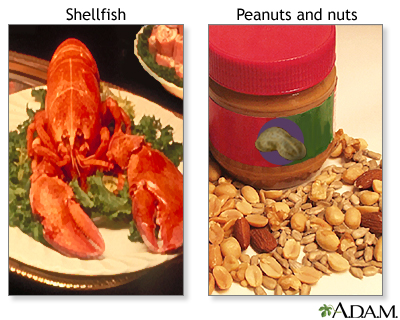| Common food allergies |
In adults, the most common foods to cause allergic reactions include: shellfish such as shrimp, lobster, and crab; peanuts, a legume that is one of the chief foods to cause severe anaphylaxis, a sudden drop in blood pressure that can be fatal if not treated quickly; tree nuts such as walnuts; and fish.
In children, the pattern is somewhat different. The most common food allergens that cause problems in children are eggs, milk, peanuts, soy, and wheat. Adults usually do not lose their allergies, but children can sometimes outgrow them. Children are more likely to outgrow allergies to milk, egg, or soy allergies to peanuts, fish, or shrimp.
The foods that adults or children react to are those foods they eat often. In Japan, for example, rice allergy is more frequent. In Scandinavia, codfish allergy is more common.

Cross Reactivity
If someone has a life-threatening reaction to a certain food, the doctor will counsel the patient to avoid similar foods that might trigger this reaction. For example, if someone has a history of allergy to shrimp, testing may show that the person is not only allergic to shrimp but also to crab, and lobster. This is called cross-reactivity.
Another interesting example of cross-reactivity occurs in people who are highly sensitive to ragweed. During ragweed pollination season, these people sometimes find that when they try to eat melons, particularly cantaloupe, they have itching in their mouth and they simply cannot eat the melon. Similarly, people who have severe birch pollen allergy also may react to apples. This is called the "oral allergy syndrome."
Exercise-Induced Food Allergy
At least one situation may require more than the simple ingestion of a food allergen to provoke a reaction: exercise-induced food allergy. People who experience this reaction eat a specific food before exercising. As they exercise and their body temperature goes up, they begin to itch, get light-headed, and soon have allergic reactions such as hives or even anaphylaxis. The cure for exercised-induced food allergy is to neat for a couple of hours before exercising, and to avoid exercising alone in case you need medical attention.
Read more about food allergies:
- How allergic reactions work
- Food allergy or food intolerance?
- Diagnosing food allergies
- Treating food allergies
- Food allergies in infants and children
- Controversial issues and unproven theories
Created by the National Institute of Allergy and Infectious Diseases. Modified and updated by A.D.A.M., Inc. Illustration copyright A.D.A.M., Inc.
Reviewed By: Paula J. Busse, MD, Assistant Professor of Medicine, Division of Clinical Immunology, Mount Sinai School of Medicine, New York, NY, Review provided by VeriMed Healthcare Network. Also reviewed by David Zieve, MD, MHA, Medical Director, A.D.A.M., Inc.
